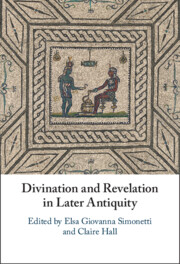Book contents
- Divination and Revelation in Later Antiquity
- Divination and Revelation in Later Antiquity
- Copyright page
- Contents
- Illustrations
- Notes on Contributors
- Acknowledgements
- Introduction
- Part I Philosophical Perspectives on Divination, Revelation, and Prophecy
- Part II Status, Role, and Functions of Human Intermediaries
- Part III Divine Transcendence and Pragmatic Purposes
- Index
- References
Part III - Divine Transcendence and Pragmatic Purposes
Published online by Cambridge University Press: 19 October 2023
- Divination and Revelation in Later Antiquity
- Divination and Revelation in Later Antiquity
- Copyright page
- Contents
- Illustrations
- Notes on Contributors
- Acknowledgements
- Introduction
- Part I Philosophical Perspectives on Divination, Revelation, and Prophecy
- Part II Status, Role, and Functions of Human Intermediaries
- Part III Divine Transcendence and Pragmatic Purposes
- Index
- References
Summary

- Type
- Chapter
- Information
- Divination and Revelation in Later Antiquity , pp. 177 - 221Publisher: Cambridge University PressPrint publication year: 2023

